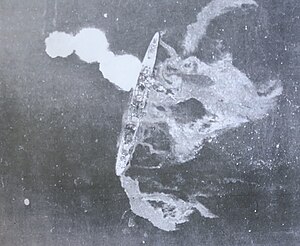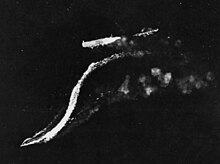 Tokitsukaze stopped dead in the water by air attacks during the Battle of the Bismarck Sea, March 4th 1943. Tokitsukaze stopped dead in the water by air attacks during the Battle of the Bismarck Sea, March 4th 1943.
| |
| History | |
|---|---|
| Name | Tokitsukaze |
| Builder | Uraga Dock Company |
| Laid down | 20 February 1939 |
| Launched | 10 November 1939 |
| Completed | 15 December 1940 |
| Stricken | 1 April 1943 |
| Fate | Sunk in action, 3 March 1943 |
| General characteristics | |
| Class and type | Kagerō-class destroyer |
| Displacement | 2,033 long tons (2,066 t) standard |
| Length | 118.5 m (388 ft 9 in) |
| Beam | 10.8 m (35 ft 5 in) |
| Draft | 3.8 m (12 ft 6 in) |
| Propulsion |
|
| Speed | 35.5 knots (40.9 mph; 65.7 km/h) |
| Range | 5,000 NM at 18 knots (21 mph; 33 km/h) |
| Complement | 239 |
| Armament |
|
Tokitsukaze (時津風, lit. "favorable wind") was the tenth vessel to be commissioned in the 19-vessel Kagerō-class destroyers built for the Imperial Japanese Navy in the late-1930s under the Circle Three Supplementary Naval Expansion Program (Maru San Keikaku).
Background
The Kagerō-class destroyers were outwardly almost identical to the preceding Asashio class, with improvements made by Japanese naval architects to improve stability and to take advantage of Japan's lead in torpedo technology. They were designed to accompany the Japanese main striking force and in both day and night attacks against the United States Navy as it advanced across the Pacific Ocean, according to Japanese naval strategic projections. Despite being one of the most powerful classes of destroyers in the world at the time of their completion, only one survived the Pacific War.
Their crew numbered 240 officers and enlisted men. The ships measured 118.5 meters (388 ft 9 in) overall, with a beam of 10.8 meters (35 ft 5 in) and a draft of 3.76 meters (12 ft 4 in). They displaced 2,065 metric tons (2,032 long tons) at standard load and 2,529 metric tons (2,489 long tons) at deep load. The ships had two Kampon geared steam turbines, each driving one propeller shaft, using steam provided by three Kampon water-tube boilers. The turbines were rated at a total of 52,000 shaft horsepower (39,000 kW) for a designed speed of 35 knots (65 km/h; 40 mph). The ships had a range of 5,000 nautical miles (9,300 km; 5,800 mi) at a speed of 18 knots (33 km/h; 21 mph).
The main armament of the Kagerō class consisted of six Type 3 127-millimeter (5.0 in) guns in three twin-gun turrets, one superfiring pair aft and one turret forward of the superstructure. They were built with four Type 96 25-millimeter (1.0 in) anti-aircraft guns in two twin-gun mounts, but more of these guns were added over the course of the war. The ships were also armed with eight 610-millimeter (24.0 in) torpedo tubes for the oxygen-fueled Type 93 "Long Lance" torpedo in two quadruple traversing mounts; one reload was carried for each tube. Their anti-submarine weapons comprised 16 depth charges.
Construction and career
Tokitsukaze was laid down on 20 February 1939 at the Uraga Dock Company. The ship was launched on 10 November 1939 and commissioned on 15 December 1940.
At the time of the attack on Pearl Harbor, Tokitsukaze, was assigned to Destroyer Division 16 (Desdiv 16), and a member of Destroyer Squadron 2 (Desron 2) of the IJN 2nd Fleet, and had deployed from Palau, as part of the escort for the aircraft carrier Ryūjō in the invasion of the southern Philippines.
In early 1942, Tokitsukaze participated in the invasion of the Netherlands East Indies, escorting the invasion forces for Menado, Kendari and Ambon in January, and the invasion forces for Timor and eastern Java in February. On 27–26 February, she participated in the Battle of the Java Sea, taking part in a torpedo attack on the Allied fleet. During the month of March, Desron 2 was engaged in anti-submarine operations in the Java Sea. At the end of the month, Tokitsukaze deployed from Ambon for the invasion of Western New Guinea. At the end of April, she returned to Kure Naval Arsenal for repairs, docking on 2 May.

On 21 May 1942, Tokitsukaze and Desron 2 steamed from Kure to Saipan, where they rendezvoused with a troop convoy and sailed toward Midway Island. Due to the defeat of the Carrier Striking Force and loss of four fleet carriers in the Battle of Midway, the invasion was called off and the convoy withdrew without seeing combat. Desdiv 16 was ordered back to Kure. On 14 July, Tokitsukaze was reassigned to the IJN 3rd Fleet and was assigned to escort the transport Nankai Maru to Rabaul, returning with the cruiser Mogami to Kure in mid-August. Tokitsukaze returned to the Solomon Islands before the end of the month, in time to participate in the Battle of the Eastern Solomons on 24 August, as an escort to Ryūjō and the cruiser Tone. After the battle, she assisted in the rescue of the survivors from Ryūjō and spent the month of September on patrols based out of Truk. She escorted the damaged carrier Taiyō to Kure for repairs in mid-October.
During the Battle of Santa Cruz Islands on 26 October, she was part of Admiral Nagumo's Strike Force. In early November, she returned to Kure with Zuikaku, and participated in training exercises in the Inland Sea through the end of the year.
After redeploying to Shortland Island, on 10 January, while providing cover for a supply-drum transport run to Guadalcanal, Tokitsukaze assisted in sinking the American PT boats PT-43 and PT-112. Through the end of February, she continued to be used as a high speed transport in the evacuation of Japanese forces from Guadalcanal.
During the Battle of Bismarck Sea on 3 March 1943, Tokitsukaze was damaged by an Allied air attack, which killed 19 crewmen and left her dead in the water. Her skipper, Cdr Masayoshi Motokura, gave the order to abandon ship, and the survivors were taken aboard the destroyer Yukikaze. The abandoned vessel was discovered southeast of Finschhafen and sunk by Allied aircraft the following morning at coordinates (07°16′S 148°15′E / 7.267°S 148.250°E / -7.267; 148.250).
She was removed from the navy list on 1 April 1943.
See also
Notes
- Nelson. Japanese-English Character Dictionary. Page 481, 544, 960;
- Peattie & Evans, Kaigun .
- Globalsecurity.org, IJN Kagero class destroyers
- Chesneau, p. 194
- ^ Whitley, pp. 200–01
- ^ Jentschura, Jung & Mickel, p. 148
- Nishidah, Hiroshi (2002). "Asashio class 1st class destroyers". Materials of the Imperial Japanese Navy. Archived from the original on 2012-07-21. Retrieved 2011-06-18.
- ^ Allyn D. Nevitt (1998). "IJN Tokitsukaze: Tabular Record of Movement". combinedfleet.com.
- Brown, David (1990). Warship Losses of World War Two. Naval Institute Press. ISBN 1-55750-914-X.
Books
- Brown, David (1990). Warship Losses of World War Two. Naval Institute Press. ISBN 1-55750-914-X.
- D'Albas, Andrieu (1965). Death of a Navy: Japanese Naval Action in World War II. Devin-Adair Pub. ISBN 0-8159-5302-X.
- Evans, David (1979). Kaigun: Strategy, Tactics, and Technology in the Imperial Japanese Navy, 1887–1941. US Naval Institute Press. ISBN 0-87021-192-7.
- Roger Chesneau, ed. (1980). Conway's All the World's Fighting Ships 1922–1946. Grenwitch: Conway Maritime Press. ISBN 0-85177-146-7.
- Howarth, Stephen (1983). The Fighting Ships of the Rising Sun: The Drama of the Imperial Japanese Navy, 1895–1945. Atheneum. ISBN 0-689-11402-8.
- Jentsura, Hansgeorg (1976). Warships of the Imperial Japanese Navy, 1869–1945. US Naval Institute Press. ISBN 0-87021-893-X.
- Watts, A.J. (1966). Japanese warships of World War II. Ian Allan. ISBN 0711002150.
- Whitley, M. J. (1988). Destroyers of World War 2. Cassell Publishing. ISBN 1-85409-521-8.
External links
- CombinedFleet.com: Kagero-class destroyers.
- CombinedFleet.com: Tabular Record of Movement of Tokitsukaze.
- "IJN Kagero class destroyers". GlobalSecurity.org.
| Kagerō-class destroyers | |
|---|---|
| |
| |